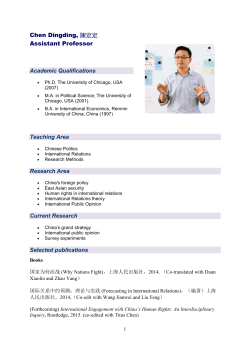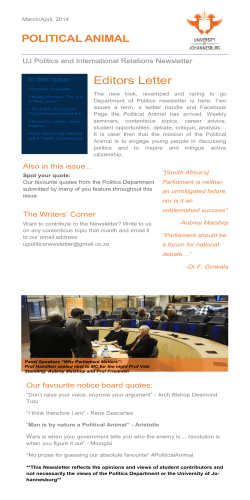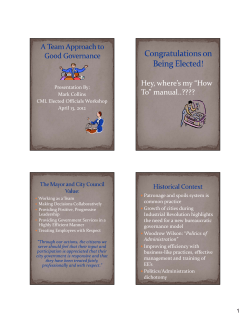
Organizational Behavior, 8e Schermerhorn, Hunt, and Osborn
Organizational Behavior, 8e Schermerhorn, Hunt, and Osborn Prepared by Michael K. McCuddy Valparaiso University John Wiley & Sons, Inc. COPYRIGHT Copyright 2003 © John Wiley & Sons, Inc. All rights reserved. Reproduction or translation of this work beyond that permitted in Section 117 of the 1976 United States Copyright Act without the express written permission of the copyright owner is unlawful. Request for further information should be addressed to the Permissions Department, John Wiley & Sons, Inc. The purchaser may make back-up copies for his/her own use only and not for distribution or resale. The Publisher assumes no responsibility for errors, omissions, or damages, caused by the use of these programs or from the use of the information contained herein. Organizational Behavior: Chapter 15 2 Chapter 15 Power and Politics Study questions. – What is power? – How do managers acquire the power needed for leadership? – What is empowerment, and how can managers empower others? – What are organizational politics? Organizational Behavior: Chapter 15 3 Chapter 15 Power and Politics Study questions. – How do organizational politics affect managers and management? – Can the firm use politics strategically? Organizational Behavior: Chapter 15 4 What is power? Power is the ability to … – Get someone to do something you want done. – Make things happen in the way you want. Influence is … – What you have when you exercise power. – Expressed by others’ behavioral response to your exercise of power. Organizational Behavior: Chapter 15 5 What is power? Position power. – Derives from organizational sources. – Types of position power. • • • • • • Reward power. Coercive power. Legitimate power. Process power. Information power. Representative power. Organizational Behavior: Chapter 15 6 What is power? Reward power. – The extent to which a manager can use extrinsic and intrinsic rewards to control other people. – Success in accessing and utilizing rewards depends on manager’s skills. Organizational Behavior: Chapter 15 7 What is power? Coercive power. – The extent to which a manager can deny desired rewards or administer punishments to control other people. – Availability varies from one organization and manager to another. Organizational Behavior: Chapter 15 8 What is power? Legitimate power. – Also known as formal hierarchical authority. – The extent to which a manager can use subordinates’ internalized values or beliefs that the “boss” has a “right of command” to control their behavior. – If legitimacy is lost, authority will not be accepted by subordinates. Organizational Behavior: Chapter 15 9 What is power? Process power. – The control over methods of production and analysis. – Places an individual in the position of: • Influencing how inputs are transformed into outputs. • Controlling the analytical process used to make choices. Organizational Behavior: Chapter 15 10 What is power? Information power. – The access to and/or control of information. – May complement legitimate hierarchical power. – May be granted to specialists and managers in the middle of the information system. – People may “protect” information in order to increase their power. Organizational Behavior: Chapter 15 11 What is power? Representative power. – The formal right conferred by the firm to speak as a representative for a potentially important group composed of individuals across departments or outside the firm. – Helps complex organizations deal with a variety of constituencies. Organizational Behavior: Chapter 15 12 What is power? Personal power. – Derives from individual sources. – Types of personal power. • Expert power. • Rational persuasion. • Referent power. Organizational Behavior: Chapter 15 13 What is power? Expert power. – The ability to control another person’s behavior through the possession of knowledge, experience, or judgment that the other person needs but does not have. – Is relative, not absolute. Organizational Behavior: Chapter 15 14 What is power? Rational persuasion. – The ability to control another person’s behavior by convincing the other person of the desirability of a goal and a reasonable way of achieving it. – Much of a supervisor’s daily activity involves rational persuasion. Organizational Behavior: Chapter 15 15 What is power? Referent power. – The ability to control another’s behavior because the person wants to identify with the power source. – Can be enhanced by linking to morality and ethics and long-term vision. Organizational Behavior: Chapter 15 16 How do managers acquire the power needed for leadership? Acquiring and using power and influence. – A considerable portion of any manager’s time is directed toward power-oriented behavior. – Power-oriented behavior is action directed at developing or using relationships in which other people are willing to defer wholly or partially to one’s wishes. Organizational Behavior: Chapter 15 17 How do managers acquire the power needed for leadership? Acquiring and using power and influence. – Three dimensions of managerial power and influence. • Downward. • Upward. • Lateral. – Effective managers build and maintain position power and personal power to exercise downward, upward, and lateral influence. Organizational Behavior: Chapter 15 18 How do managers acquire the power needed for leadership? Building position power by: – Increasing centrality and criticality in the organization. – Increasing task relevance of own activities and work unit’s activities. – Attempting to define tasks so they are difficult to evaluate. Organizational Behavior: Chapter 15 19 How do managers acquire the power needed for leadership? Building personal power by: – Building expertise. • Advanced training and education, participation in professional associations, and project involvement. – Learning political savvy. • Learning ways to negotiate, persuade, and understand goals and means that others accept. – Enhancing likeability. • Pleasant personality characteristics, agreeable behavior patterns, and attractive personal appearance. Organizational Behavior: Chapter 15 20 How do managers acquire the power needed for leadership? Managers increase the visibility of their job performance by: – Expanding contacts with senior people. – Making oral presentations of written work. – Participating in problem-solving task forces. – Sending out notices of accomplishment. – Seeking opportunities to increase name recognition. Organizational Behavior: Chapter 15 21 How do managers acquire the power needed for leadership? Additional tactics for acquiring and using power and influence. – Using coalitions and networks to alter the flow of information and the analytical context. – Controlling, or at least influencing, decision premises. – Making one’s own goals and needs clear. – Bargaining effectively regarding one’s preferred goals and needs. Organizational Behavior: Chapter 15 22 How do managers acquire the power needed for leadership? Common strategies for turning power into relational influence. – Reason. – Friendliness. – Coalition. – Bargaining. – Assertiveness. – Higher authority. – Sanctions. Organizational Behavior: Chapter 15 23 How do managers acquire the power needed for leadership? Power, formal authority, and obedience. – The Milgram experiments. • Designed to determine the extent to which people obey the commands of an authority figure, even under the belief of life-threatening conditions. • The results indicated that the majority of the experimental subjects would obey the commands of the authority figure. • Raised concerns about compliance and obedience. Organizational Behavior: Chapter 15 24 How do managers acquire the power needed for leadership? Obedience and the acceptance of authority. – Chester Barnard argued that: • Authority derives from the “consent of the governed.” • Subordinates accept or follow a directive only under special circumstances. Organizational Behavior: Chapter 15 25 How do managers acquire the power needed for leadership? Obedience and the acceptance of authority — cont. – For a directive to be accepted as authoritative, the subordinate: • Can and must understand it. • Must feel mentally and physically capable of carrying it out. • Must believe that it is consistent with the organization’s purpose. • Must believe that it is consistent with his or her personal interests. Organizational Behavior: Chapter 15 26 How do managers acquire the power needed for leadership? Obedience and the acceptance of authority — cont. – Directives that meet the four criteria will be accepted as authoritative since they fall within the “zone of indifference.” – Directives falling within the zone are obeyed. – Directives falling outside the zone are not obeyed. – The zone is not fixed over time. Organizational Behavior: Chapter 15 27 What is empowerment, and how can managers empower others? Empowerment. – The process by which managers help others to acquire and use the power needed to make decisions affecting themselves and their work. – Considers power to be something that can be shared by everyone working in flatter and more collegial organizations. – Provides the foundation for self-managing work teams and other employee involvement groups. Organizational Behavior: Chapter 15 28 What is empowerment, and how can managers empower others? The power keys to empowerment. – Traditional view. • Power is relational in terms of individuals. – Empowerment view. • Emphasis is on the ability to make things happen. • Power is relational in terms of problems and opportunities, not individuals. Organizational Behavior: Chapter 15 29 What is empowerment, and how can managers empower others? The power keys to empowerment. – Ways to empower others. • Changing position power. • Expanding the zone of indifference. Organizational Behavior: Chapter 15 30 What is empowerment, and how can managers empower others? Power as an expanding pie. – With empowerment, employees must be trained to expand their power and their new influence potential. – Empowerment changes the dynamics between supervisors and subordinates. Organizational Behavior: Chapter 15 31 What is empowerment, and how can managers empower others? Ways to expand power. – Clearly define roles and responsibilities. – Provide opportunities for creative problem solving coupled with the discretion to act. – Emphasize different ways of exercising influence. – Provide support to individuals so they become comfortable with developing their power. – Expand inducements for thinking and acting, not just obeying. Organizational Behavior: Chapter 15 32 What are organizational politics? Machiavellian tradition of organizational politics. – Emphasizes self-interest and the use of nonsanctioned means. – Organizational politics is defined as the management of influence to obtain ends not sanctioned by the organization or to obtain sanctioned ends through nonsanctioned influence means. Organizational Behavior: Chapter 15 33 What are organizational politics? Alternate tradition of organizational politics. – Politics is a necessary function resulting from differences in the self-interests of individuals. – Politics is the art of creative compromise among competing interests. – Politics is the use of power to develop socially acceptable ends and means that balance individual and collective interests. Organizational Behavior: Chapter 15 34 What are organizational politics? Positive aspects of organizational politics. – Overcoming personnel inadequacies. – Coping with change. – Substituting for formal authority. Organizational Behavior: Chapter 15 35 What are organizational politics? Organizational politics and self-protection. – Common self-protection strategies. • Avoiding action and risk taking. • Redirecting accountability and responsibility. • Defending turf. Organizational Behavior: Chapter 15 36 What are organizational politics? Common techniques for avoiding action and risk taking. – Working to the rule. – Playing dumb. – Depersonalization. – Stalling. • Routine. • Creative. Organizational Behavior: Chapter 15 37 What are organizational politics? Common techniques for redirecting accountability and responsibility. – Passing the buck. – Buffing (or rigorous documentation). – Rewriting history. – Scapegoating. – Blaming the problem on uncontrollable events. – Escalating commitment to a losing course of action. Organizational Behavior: Chapter 15 38 What are organizational politics? Common techniques for defending turf. – Expanding the jobs performed by the work unit. – Forming and using coalitions. Organizational Behavior: Chapter 15 39 How do organizational politics affect managers and management? Managers may gain a better understanding of political behavior by placing themselves in the positions of other persons involved in critical decisions or events. This understanding can be facilitated with the use of a payoff matrix analysis. Organizational Behavior: Chapter 15 40 How do organizational politics affect managers and management? Political action and subunit power. – Common types of lateral, intergroup relationships where political action occurs. • Work-flow linkage. • Service ties. • Advisory connections. • Auditing linkages. • Approval linkages. Organizational Behavior: Chapter 15 41 How do organizational politics affect managers and management? Political action in the chief executive suite. – Executive behavior can sometimes be explained in terms of resource dependencies. – Resource dependence increases as: • Needed resources become more scarce. • Outsiders have more control over needed resources. • There are fewer substitutes for a particular type of resource controlled by a limited number of outsiders. Organizational Behavior: Chapter 15 42 How do organizational politics affect managers and management? Strategies for managing resource dependencies. – Developing workable compromises among competing resource dependencies. – Altering the firm’s degree of resource dependence. – Redefining how the firm expects to conduct business in the international arena. – Determining the proper level of executive pay. Organizational Behavior: Chapter 15 43 Can the firm use politics strategically? There is growing awareness of the importance of political strategy for business firms. In the United States, corporate political strategy advises managers to: – Engage in the public political process. – Turn the government from an industry regulator to an industry protector. – Decide when and how to get involved in the public policy process. Organizational Behavior: Chapter 15 44 Can the firm use politics strategically? Organizational governance. – The pattern of authority, influence, and acceptable managerial behavior established at the top of the organization. – Significantly determined by the effective control of key resources by members of a dominant coalition. Organizational Behavior: Chapter 15 45 Can the firm use politics strategically? Organizational governance implications. – The daily practice of governance is the development and resolution of issues. – Governance is becoming more public and open. – Imbalanced governance by some U.S. corporations may limit their ability to manage global operations effectively. Organizational Behavior: Chapter 15 46 Can the firm use politics strategically? Organizational governance implications. – While governance is often closely tied to the short-term interests of stockholders and pay of CEOs, some firms are expanding governance interests to include employees and communities. – Governance should have an ethical basis. Organizational Behavior: Chapter 15 47 Can the firm use politics strategically? A person’s behavior must satisfy the following criteria to be ethical: – The behavior must produce the greatest good for the greatest number of people. – The behavior must respect the rights of all affected parties. – The behavior must respect the rules of justice. Organizational Behavior: Chapter 15 48 Can the firm use politics strategically? CEOs and employees may justify unethical actions by suggesting that the behavior: – Is not really illegal and so could be moral. – Appears to be in the firm’s best interest. – Is unlikely to be detected. – Demonstrates loyalty. Organizational Behavior: Chapter 15 49
© Copyright 2025

















